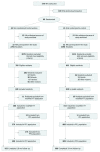Systematic Dementia Screening by Multidisciplinary Team Meetings in Nursing Homes for Reducing Emergency Department Transfers: The IDEM Cluster Randomized Clinical Trial
- PMID: 32101308
- PMCID: PMC7137681
- DOI: 10.1001/jamanetworkopen.2020.0049
Systematic Dementia Screening by Multidisciplinary Team Meetings in Nursing Homes for Reducing Emergency Department Transfers: The IDEM Cluster Randomized Clinical Trial
Abstract
Importance: Dementia is often underdiagnosed in nursing homes (NHs). This potentially results in inappropriate care, and high rates of emergency department (ED) transfers in particular.
Objective: To assess whether systematic dementia screening of NH residents combined with multidisciplinary team meetings resulted in a lower rate of ED transfer at 12 months compared with usual care.
Design, setting, and participants: Multicenter, cluster randomized trial with NHs as the unit of randomization. The IDEM (Impact of Systematic Tracking of Dementia Cases on the Rate of Hospitalization in Emergency Care Units) trial took place at 64 public and private NHs in France. Recruitment started on May 1, 2010, and was completed on March 31, 2012. Residents who were aged 60 years or older, had no diagnosed or documented dementia, were not bedridden, had lived in the NH for at least 1 month at inclusion, and had a life expectancy greater than 12 months were included. The residents were followed up for 18 months. The main study analyses were completed on October 14, 2016.
Intervention: Two parallel groups were compared: an intervention group consisting of NHs that set up 2 multidisciplinary team meetings to identify residents with dementia and to discuss an appropriate care plan, and a control group consisting of NHs that continued their usual practice. During the inclusion period of 23 months, all residents of participating NHs who met eligibility criteria were included in the study.
Main outcomes and measures: The primary end point (ED transfer) was analyzed at 12 months, but the residents included were followed up for 18 months.
Results: A total of 64 NHs participated in the study and enrolled 1428 residents (mean [SD] age, 84.7 [8.1] years; 1019 [71.3%] female): 599 in the intervention group (32 NHs) and 829 in the control group (32 NHs). The final study visit was completed by 1042 residents (73.0%). The main reason for early discontinuation was death (318 residents [22.7%]). The intervention did not reduce the risk of ED transfers during the 12-month follow-up: the proportion of residents transferred at least once to an ED during the 12-month follow-up was 16.2% in the intervention group vs 12.8% in the control group (odds ratio, 1.32; 95% CI, 0.83-2.09; P = .24).
Conclusions and relevance: This study failed to demonstrate that systematic screening for dementia in NHs resulted in fewer ED transfers. The findings do not support implementation of multidisciplinary team meetings for systematic dementia screening of all NH residents, beyond the national recommendations for dementia diagnosis, to reduce ED transfers.
Trial registration: ClinicalTrials.gov Identifier: NCT01569997.
Conflict of interest statement
Figures
Similar articles
-
Effects of an Intervention to Reduce Hospitalizations From Nursing Homes: A Randomized Implementation Trial of the INTERACT Program.JAMA Intern Med. 2017 Sep 1;177(9):1257-1264. doi: 10.1001/jamainternmed.2017.2657. JAMA Intern Med. 2017. PMID: 28672291 Free PMC article. Clinical Trial.
-
Factors Associated with Potentially Inappropriate Transfer to the Emergency Department among Nursing Home Residents.J Am Med Dir Assoc. 2021 Dec;22(12):2579-2586.e7. doi: 10.1016/j.jamda.2021.04.002. Epub 2021 May 5. J Am Med Dir Assoc. 2021. PMID: 33964225
-
Cluster-Controlled Trial of an Intervention to Improve Prescribing in Nursing Homes Study.J Am Med Dir Assoc. 2019 Nov;20(11):1404-1411. doi: 10.1016/j.jamda.2019.06.006. Epub 2019 Aug 8. J Am Med Dir Assoc. 2019. PMID: 31402136 Clinical Trial.
-
Appropriateness of transferring nursing home residents to emergency departments: a systematic review.BMC Geriatr. 2019 Jan 21;19(1):17. doi: 10.1186/s12877-019-1028-z. BMC Geriatr. 2019. PMID: 30665362 Free PMC article.
-
Age and sex differences in emergency department visits of nursing home residents: a systematic review.BMC Geriatr. 2018 Jul 3;18(1):151. doi: 10.1186/s12877-018-0848-6. BMC Geriatr. 2018. PMID: 29970027 Free PMC article.
Cited by
-
Do not PIMP my nursing home ride! The impact of Potentially Inappropriate Medications Prescribing on residents' emergency care use.Eur J Health Econ. 2023 Sep;24(7):1085-1100. doi: 10.1007/s10198-022-01534-x. Epub 2022 Oct 21. Eur J Health Econ. 2023. PMID: 36271304 Clinical Trial.
-
Preventing autonomy loss with multicomponent geriatric interventions: A resource-saving strategy? Evidence from the SPRINT-T study.SSM Popul Health. 2023 Oct 5;24:101507. doi: 10.1016/j.ssmph.2023.101507. eCollection 2023 Dec. SSM Popul Health. 2023. PMID: 37860705 Free PMC article.
-
Models for delivery and co-ordination of primary or secondary health care (or both) to older adults living in aged care facilities.Cochrane Database Syst Rev. 2024 Mar 1;3(3):CD013880. doi: 10.1002/14651858.CD013880.pub2. Cochrane Database Syst Rev. 2024. PMID: 38426600 Free PMC article.
-
Which interventions are effective at decreasing or increasing emergency department attendances or hospital admissions from long-term care facilities? A systematic review.BMJ Open. 2023 Feb 2;13(2):e064914. doi: 10.1136/bmjopen-2022-064914. BMJ Open. 2023. PMID: 36731926 Free PMC article.
-
Impact of a complex health services intervention in long-term care nursing homes on 3-year overall survival: results from the CoCare study.BMC Health Serv Res. 2024 Feb 14;24(1):203. doi: 10.1186/s12913-024-10635-7. BMC Health Serv Res. 2024. PMID: 38355493 Free PMC article.
References
Publication types
MeSH terms
Associated data
LinkOut - more resources
Full Text Sources
Medical
Miscellaneous


